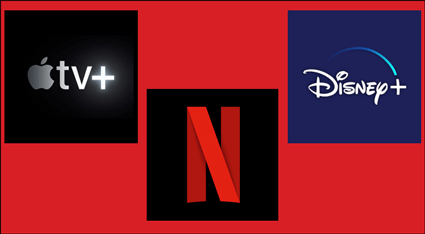As the streaming wars heat up, both Apple and Disney have announced new streaming services to compete with Netflix, but there’s another possibility. Center director Jeffrey Cole explains in a new column.
______________________________
By Jeffrey Cole
This is the year the video streaming wars begin. By the end of 2019, Netflix’s and Hulu’s iron grip on subscription streaming (filled with old TV shows, old theatrical films, and massive amounts of original programming) will face serious competition for a monthly piece of the consumer’s wallet.
 Netflix began as the red envelope company charging a monthly subscription ($14-18) to get DVDs of recent films through the mail. Unlike at Blockbuster, there were no late fees.
Netflix began as the red envelope company charging a monthly subscription ($14-18) to get DVDs of recent films through the mail. Unlike at Blockbuster, there were no late fees.
In 2011, Reid Hastings, the founder of Netflix, decided to bet on streaming and divided the company in half: Qwikster continued the red envelope tradition while Netflix focused on streaming. Within a few years, the DVD-by-mail business receded, and Netflix became the streaming giant. Soon they added old television shows. This year, Netflix is investing $12 billion in original programming.
Netflix grew at an astonishing pace and now has 150 million subscribers reaching almost every country on Earth except China. They launched in Australia in March of 2015. In that country of 9 million households, Netflix soon had one million subscribers, all without a single employee in the country.
Netflix was growing so rapidly that they could afford to buy massive amounts of content from the six (now 5) movie studios as well as go to them to create original programming. The studios, looking at this massive windfall, were eager to sell to Netflix.
As will become very relevant later, some of those deals for theatrical films (Marvel, for example) run through much of the next decade. The money made by selling to Netflix was enormous and it required little effort from the studios since the content was already produced. Last December, just to get one more year on Netflix of Friends (a show whose last episode premiered 15 years ago), Warner Bros earned $100 million.
____________________________________________________________________________________________
Disney is the undisputed king of the entertainment world, and it never takes its eyes off its customers. More importantly, the fate of Disney+ will determine the future of the company. The future of the entertainment business is consumer subscriptions for streaming, so Disney has to get this right.
______________________________________________________________________________________________
As the studios were reaping the financial windfall from Netflix, they soon realized they were building a massive competitor who would (or perhaps already did?) control the market. Looking at consumer spending on television and video, Netflix had a solid lock on the first $10 of monthly spending.
Disney and Apple: new competitors for Netflix
Disney was the first to recognize the danger. As the most successful producer of theatrical film, they had the most to lose if Netflix continued to grow and dominate the market. They also had the best array of content to take on the streaming giant (Marvel, Lucasfilm, Pixar, and its own Disney label). On August 8, 2017, Disney CEO Bob Iger announced the company would no longer sell content to Netflix; it would instead launch its own competing streaming service.
That same year, Tim Cook at Apple brought to the company two of Sony Television’s best production executives: Jamie Erlicht and Zack Van Amburg. Apple did not yet have a clear strategy, but in essence it said to the two execs: “Guys, we’re not sure what we want to do in video and streaming. Look around, let’s dabble.”
Then, Cook, as if he were digging into his pocket to find spare change, added, “Here’s two billion dollars, see what you can do.” To Apple, soon to be a trillion dollar company, this was indeed spare change.
Apple started plans to put original programming into production. It was unclear what their distribution plans were, but it was likely they would create their own channel.
Even though Apple and Disney are separate companies, they barely compete, and they have always had a synergistic relationship.
Cut to 2019, both companies unveil their streaming channels. On March 25, Apple announced Apple TV+. It will be a subscription video service available on Apple devices as well as those of its competitors. Few details (including pricing) were made available. At the same event, Apple also announced a new Apple Pay credit card and a news service offering a flat monthly fee ($10) for a variety of magazines.
Less than three weeks later, Disney previewed its streaming service and provided far more details. The new channel will be called Disney+ (until the name was revealed, fans of Disney referred to the upcoming service as Mouseflix). The new service will begin on November 12 at a cost $6.99 a month. At the preview, a slate of original programming was announced that included new streaming versions of Marvel and Star Wars stories.
Disney received enormous praise for its preview of Disney+ and how it will compete with Netflix. The reviews on the Apple TV+ event were underwhelming.
____________________________________________________________________________________________
This year, Netflix is investing $12 billion in original programming. Netflix grew at an astonishing pace and now has 150 million subscribers reaching almost every country on Earth except China. They launched in Australia in March of 2015. In that country of 9 million households, Netflix soon had one million subscribers, all without a single employee in the country.
______________________________________________________________________________________________
My good friend and colleague at UCLA’s Anderson School of Management, George T. Geis, did a content analysis of 1731 news articles in March and April of this year. Geis found that much of the coverage of Apple highlighted the celebrities at the event, with frequent mentions of Steven Spielberg, Oprah Winfrey, Reese Witherspoon, and Jennifer Aniston. Coverage of the Disney event focused more on the structure and pricing of its new streaming service.
Why Disney did it better
It’s no surprise that Disney was better prepared for its coming out party than was Apple. Disney is the undisputed king of the entertainment world, and it never takes its eyes off its customers. More importantly, the fate of Disney+ will determine the future of the company. Disney is unrivaled in the world of feature film, maintaining the biggest share of box office of any studio in Hollywood history. Already this year, the studio has released Avengers: Endgame, the second biggest film ever (without factoring in inflation) and Aladdin. Still to come are the live-action Lion King, Toy Story 4, and the latest Star Wars.
The future of the entertainment business is consumer subscriptions for streaming, so Disney has to get this right.
In contrast, getting into streaming is not a make or break move for Apple. While it is experiencing an innovation drought (see our earlier columns on this topic), the entertainment business remains a rounding error to the sometimes trillion-dollar company. At Disney, you can feel the “pedal to the metal” vibe. Apple seems to be dithering.
Disney is right: there is room for another streaming service. Disney is the only movie studio that has ever had a brand, and that brand deeply resonates with consumers around the world. The $7 price will require little hesitation by many parents. Disney also has unique opportunities to bundle Hulu (which it now controls) and ESPN into a triple play.
It remains to be seen if Apple has the determination to stick with the entertainment business. It’s a far different business from collecting enormous royalties from phone companies and selling products directly at the Apple Store.
In the next three years, it is increasingly likely that Apple defers to Disney in the entertainment space. As mentioned earlier, there is a strong relationship between the two. Bob Iger sits on the Apple Board. Disney’s second biggest shareholder is Laurene Powell Jobs, widow of Apple’s co-founder, Steve Jobs. Most compelling, both companies are market leaders with a strong commitment to family content and experiences.
Look for Apple to make its real move into entertainment and to solve its innovation crisis by acquiring Disney. Apple is about four times the size of Disney and could buy the studio in cash.
Apple wouldn’t even show a bulge as Disney was digested.
____________

Jeffrey Cole is the founder and director of The Center for the Digital Future at USC Annenberg.
See all columns from the center.
June 4, 2019

